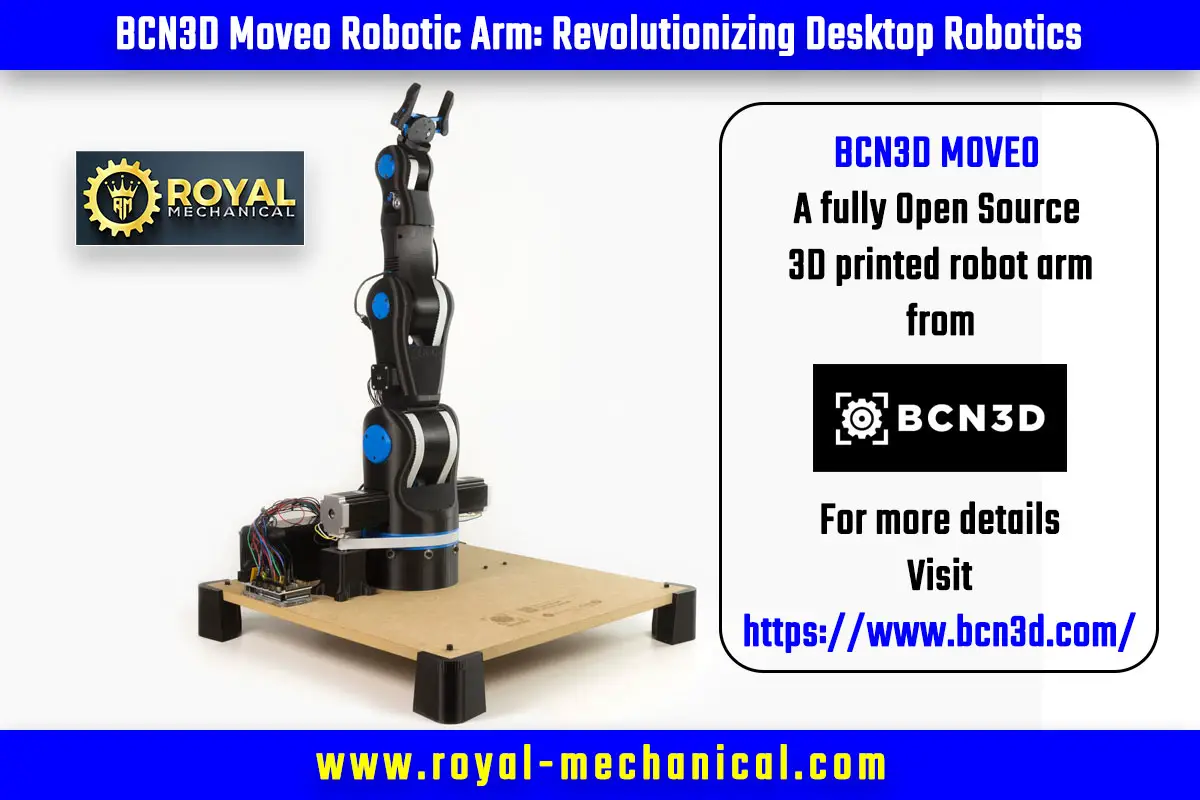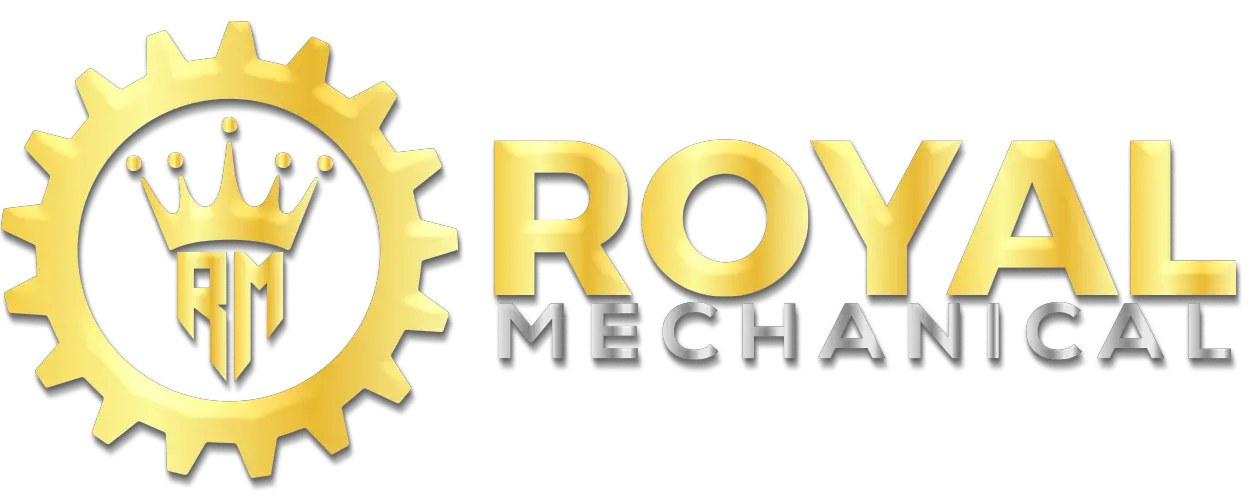
Introduction:
The BCN3D Moveo Robotic Arm has emerged as a game-changer in robotics. This innovative creation has redefined what is possible in desktop robotics, enabling enthusiasts, students, and professionals to explore the endless possibilities of automation. With its advanced features, remarkable flexibility, and open-source nature, the BCN3D Moveo Robotic Arm has become a popular choice for those looking to delve into the world of robotics. In this article, we will take a deep dive into the BCN3D Moveo Robotic Arm, exploring its design, capabilities, and impact on the robotics community.
BCN3D MOVEO is a fully Open Source 3D-printed robot arm from BCN3D. For more information, Visit
Table of Contents
The Design and Structure:
The BCN3D Moveo Robotic Arm is an impressive piece of engineering designed to provide an authentic robotic arm experience on a desktop scale. Its sleek and compact design makes it an ideal addition to any workspace. The arm comprises multiple linked segments, mimicking the structure and movement of a human arm. This design allows for a wide range of motion, with six degrees of freedom (DOF), to precisely position the arm in any desired location and orientation.
Each BCN3D Moveo Robotic Arm segment is powered by high-precision stepper motors, ensuring accurate movement and positioning. The arm also incorporates a set of robust aluminum extrusion profiles, providing strength and stability. These profiles are easily customizable, allowing users to modify and adapt the arm’s structure according to their needs. The sleek design, precise stepper motors, and flexible construction make the BCN3D Moveo Robotic Arm a versatile tool for various applications.
Open-Source Advantage:
One of the most significant advantages of the BCN3D Moveo Robotic Arm is its open-source nature. BCN3D, the company behind the arm, has made the entire design and software freely available to the public. This open-source approach fosters collaboration, innovation, and knowledge sharing within the robotics community.
BCN3D empowers users to modify, customize, and improve the robotic arm based on their unique requirements by providing access to the design files and source code. This open ecosystem has led to the development of numerous upgrades, extensions, and accessories by the community, enhancing the capabilities and functionality of the BCN3D Moveo Robotic Arm even further.
Moreover, the open-source nature of the BCN3D Moveo Robotic Arm promotes education and learning. Students, researchers, and enthusiasts can study and understand the intricacies of robotics by exploring the arm’s design and code. It is an invaluable resource for educational institutions, enabling students to gain hands-on experience in robotics, mechatronics, and automation.
Application and Versatility:
The BCN3D Moveo Robotic Arm’s versatility extends beyond its physical design and open-source nature. It offers various applications, making it suitable for multiple fields, including education, research, prototyping, and small-scale industrial processes.
In educational settings, the BCN3D Moveo Robotic Arm is an exceptional teaching tool, introducing students to the principles of robotics, mechanics, and programming. It enables hands-on learning experiences, allowing students to grasp complex concepts practically. The arm’s accessibility and ease of use make it an ideal choice for robotics clubs, STEM programs, and workshops.
The BCN3D Moveo Robotic Arm offers researchers and innovators a platform to experiment and develop new applications. Its open-source nature encourages customization and modification, enabling users to integrate additional sensors, grippers, or tools for specific tasks. This flexibility opens doors to applications in automation, human-machine interaction, and even advanced research in fields such as prosthetics or rehabilitation.
Furthermore, the BCN3D Moveo Robotic Arm can be employed in prototyping processes, aiding in developing and testing new products. It can mimic complex human arm movements, allowing precise manipulation and control. This capability is precious for companies or individuals working on projects that involve assembly, inspection, or intricate movements.
Future Prospects and Community Impact:
The BCN3D Moveo Robotic Arm has already made a significant impact on the robotics community since its introduction. The open-source approach has sparked a vibrant community of developers, researchers, and enthusiasts who continuously contribute to its growth. As the community expands, we expect to see more advancements, improvements, and creative applications of the BCN3D Moveo Robotic Arm.
Regarding future prospects, the BCN3D Moveo Robotic Arm is a stepping stone for aspiring roboticists and engineers. Providing an accessible and affordable platform, it lowers the barrier to entry. It encourages more individuals to explore the world of robotics. This democratization of robotics has the potential to drive innovation, foster collaboration, and accelerate the development of new technologies in the field.
Conclusion:
The BCN3D Moveo Robotic Arm represents a remarkable leap in desktop robotics, offering an unparalleled combination of design, versatility, and open-source accessibility. Its sleek structure, six degrees of freedom, and adaptability make it an invaluable tool for education, research, and prototyping. The open-source ecosystem surrounding the arm has facilitated a community-driven approach, leading to continuous improvements and innovative applications. As the robotics landscape evolves, the BCN3D Moveo Robotic Arm will continue to inspire, educate, and empower individuals to explore the vast possibilities of automation and robotics.
FAQs: BCN3D Moveo Robotic Arm
What is the BCN3D Moveo Robotic Arm?
The BCN3D Moveo Robotic Arm is a desktop-scale robotic arm designed to mimic the movement and functionality of a human arm. It consists of multiple linked segments with six degrees of freedom (DOF), allowing precise positioning and orientation.
What are the main features of the BCN3D Moveo Robotic Arm?
The BCN3D Moveo Robotic Arm features a sleek and compact design, high-precision stepper motors for accurate movement, and robust aluminum extrusion profiles for strength and stability. It is an open-source platform, allowing users to modify and customize the arm to suit their specific requirements.
How does the BCN3D Moveo Robotic Arm work?
The BCN3D Moveo Robotic Arm operates through the coordinated movement of its multiple linked segments, driven by stepper motors. The motors are controlled via programming or manual input to achieve precise positioning and manipulation of objects.
Is the BCN3D Moveo Robotic Arm suitable for beginners in robotics?
Yes, the BCN3D Moveo Robotic Arm is suitable for beginners in robotics. Its open-source nature and accessibility make it an excellent learning tool, allowing beginners to understand the principles of robotics, mechanics, and programming hands-on.
Can the BCN3D Moveo Robotic Arm be used for educational purposes?
Absolutely. The BCN3D Moveo Robotic Arm is widely used for educational purposes, serving as a valuable teaching tool. It helps students gain practical experience in robotics, mechatronics, and automation. It is often utilized in robotics clubs, STEM programs, and workshops.
What programming languages are compatible with the BCN3D Moveo Robotic Arm?
The BCN3D Moveo Robotic Arm can be programmed using various languages, including Arduino-based programming languages such as C/C++, Python, and other compatible languages that can communicate with the control board.
How can I customize and modify the BCN3D Moveo Robotic Arm to suit my needs?
The BCN3D Moveo Robotic Arm’s open-source nature allows for customization and modification. Users can access the design files and source code to adapt the arm’s structure, integrate additional sensors or grippers, and develop new applications based on their needs.
Are there any limitations to the BCN3D Moveo Robotic Arm’s range of motion?
While the BCN3D Moveo Robotic Arm offers a wide range of motion with its six degrees of freedom, it is essential to note that its range of motion is limited to the design and structure of the arm. The segments’ length and size determine the arm’s maximum reach.
Can the BCN3D Moveo Robotic Arm be used for industrial applications?
While the BCN3D Moveo Robotic Arm is primarily designed for desktop-scale applications, it can be utilized for specific small-scale industrial processes, such as assembly, inspection, or precise manipulation of objects.
What are some potential research applications of the BCN3D Moveo Robotic Arm?
The BCN3D Moveo Robotic Arm has the potential for various research applications. It can be used in human-machine interaction studies, automation research, prosthetics, rehabilitation, and more. Its open-source nature allows researchers to customize and adapt it to their research needs.
How accurate is the BCN3D Moveo Robotic Arm in positioning and movement?
The BCN3D Moveo Robotic Arm is capable of precise positioning and movement due to its high-precision stepper motors. However, calibration, environmental conditions, and the specific application can also influence the overall accuracy.
Can additional sensors or grippers be integrated with the BCN3D Moveo Robotic Arm?
Additional sensors and grippers can be integrated with the BCN3D Moveo Robotic Arm. The open-source nature of the arm allows users to customize and add functionalities by integrating various sensors, grippers, or other tools to extend its capabilities.
Are there any tutorials or resources available for learning how to use the BCN3D Moveo Robotic Arm?
Yes, tutorials and resources are available to help users learn how to use the BCN3D Moveo Robotic Arm. The BCN3D website, online communities, and forums dedicated to robotics often provide guides, tutorials, and documentation to assist users in getting started and exploring the arm’s capabilities.
Is the BCN3D Moveo Robotic Arm capable of autonomous operation?
The BCN3D Moveo Robotic Arm does not have autonomous operation capabilities by default. However, by integrating additional components, such as sensors and an appropriate control system, users can develop autonomous functionalities and enable the arm to perform tasks without continuous manual input.
What are the power requirements for the BCN3D Moveo Robotic Arm?
The BCN3D Moveo Robotic Arm typically requires a power supply of 12V, which can be provided through a suitable power adapter or battery pack.
Can the BCN3D Moveo Robotic Arm be controlled remotely?
Yes, the BCN3D Moveo Robotic Arm can be controlled remotely. Users can send commands and control the arm from a distance by implementing a wireless communication system, such as Bluetooth or Wi-Fi.
Are there any safety considerations when operating the BCN3D Moveo Robotic Arm?
When operating the BCN3D Moveo Robotic Arm, it is important to follow standard safety precautions. Ensure that the arm is not overloaded, avoid placing hands or objects in the arm’s path during operation, and be cautious when testing or experimenting with new functionalities.
How does the BCN3D Moveo Robotic Arm compare to similar robotic arms?
The BCN3D Moveo Robotic Arm stands out in its open-source nature, affordability, and compact design. While other robotic arms are available in the market, the BCN3D Moveo Robotic Arm offers a unique combination of features and flexibility, making it a popular choice among robotics enthusiasts and educators.
Can the BCN3D Moveo Robotic Arm be used with other robotic systems?
The BCN3D Moveo Robotic Arm can be used with other robotic systems. It can be integrated into larger robotic setups or other components to create complex automation systems.
What are some of the success stories or notable projects accomplished using the BCN3D Moveo Robotic Arm?
The BCN3D Moveo Robotic Arm has been used in various successful projects and research initiatives. Some notable examples include its use in educational institutions to teach robotics, research applications in human-robot interaction studies, and prototyping processes in product development. The open-source nature of the arm has led to a vibrant community where users share their projects and innovations.


![01) Mechanical Engineering Jobs for Freshers in 24 Weeks: A Step-by-Step Guide [ TARGET 24 ] 3 01) Mechanical Engineering Jobs for Freshers in 24 Weeks: A Step-by-Step Guide [ TARGET 24 ]](https://www.royal-mechanical.com/wp-content/uploads/2023/02/Mechanical-Engineering-Jobs-for-Freshers-768x512.jpg)



